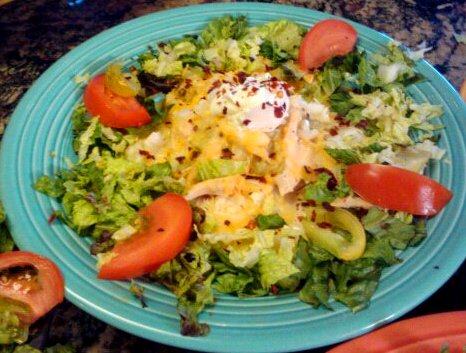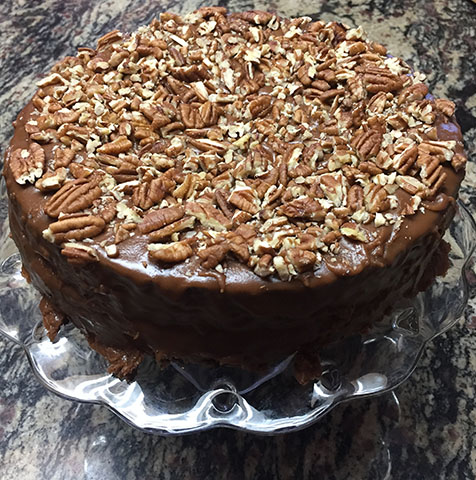The Magic of Caribe Chile...Especially when Paired with Chocolate
 Caribe chiles were developed by the Caribe Indians--indigenous to the Caribean. The legend goes that the Conquistadores on the first voyage to the Americas in 1492 requested to be "wintered over" for the first winter before setting foot in the Americas--supposedly on Cozumel Island off Mexico. The Indians were not particularly happy about the responsibility--but did not let that decrease their hospitality. The story goes that they had in their faith that Angels with light skin would someday be their Saviour. Not being sure whether the Conquistadoes were the Angels or not--they were very beneficient to them--giving them generous gifts of their culture. One of the major ones was the special caribe chile--perhaps the world's first domesticated chile.
Caribe chiles were developed by the Caribe Indians--indigenous to the Caribean. The legend goes that the Conquistadores on the first voyage to the Americas in 1492 requested to be "wintered over" for the first winter before setting foot in the Americas--supposedly on Cozumel Island off Mexico. The Indians were not particularly happy about the responsibility--but did not let that decrease their hospitality. The story goes that they had in their faith that Angels with light skin would someday be their Saviour. Not being sure whether the Conquistadoes were the Angels or not--they were very beneficient to them--giving them generous gifts of their culture. One of the major ones was the special caribe chile--perhaps the world's first domesticated chile.
The caribe seeds were presented in leather bags to be sown whenever they got to where they were going to settle. The Conquistadores were given a one way trip to the Americas and were promised a land grant from the King once they had claimed as much land as possible for the Spanish flag. The site they selected was north of Santa Fe in the beautiful Sangre de Christo mountain valley in a village still going very strong, called Chimayo. In fact the Santaurio there is often called the Lourdes of America, as the dry spring in the corner off the nave of the church has a special healing aspect. Crutches and all manner of orthopedic devices are hanging from the walls that pilgrims left there after rubbing this special soil on their "pained parts".
Among locals there is a bit of confusion whether any crushed chile is Caribe. No is the answer. Caribe is a variety, not a process.
 My family has always loved caribe as an ingredient, a condiment and as a garnish. One of our favorite savory dishes using caribe is Carne Adobado which has a huge history also, which I will share with you one day. Caribe is one of the best Chiles for pairing with chocolate because of it's inherent sweet heat. As a condiment--I use it as a substitute for salt--having a little votive dish on my table at all times for sprinkling on grilled corn, pasta dishes and vegetable dishes of all kinds, especially greens. As a garnish, I call it a confetti sprinkle on everything from Green Chile Chicken Enchiladas to Quesadillas and lots of dishes in between. ( I constantly remember that eating 1/2 teaspoon a day of the hottest chile you can endure at least 60% of the time , or say, 20 out of every 30 months, keeps cancer and heart disease away--so having it as a condiment fills that bill!)
My family has always loved caribe as an ingredient, a condiment and as a garnish. One of our favorite savory dishes using caribe is Carne Adobado which has a huge history also, which I will share with you one day. Caribe is one of the best Chiles for pairing with chocolate because of it's inherent sweet heat. As a condiment--I use it as a substitute for salt--having a little votive dish on my table at all times for sprinkling on grilled corn, pasta dishes and vegetable dishes of all kinds, especially greens. As a garnish, I call it a confetti sprinkle on everything from Green Chile Chicken Enchiladas to Quesadillas and lots of dishes in between. ( I constantly remember that eating 1/2 teaspoon a day of the hottest chile you can endure at least 60% of the time , or say, 20 out of every 30 months, keeps cancer and heart disease away--so having it as a condiment fills that bill!)
We still have a few openings for our "Chiles and Chocolate" class coming on June 18 where we will be pairing the wonderful flavors the two create for literally a dance on your palate. The class features such wonderful favorites as Chocolate Chile Cupcakes, Cocoa Dusted Truffles, Hot Hot Chocolate Cake with Fudge Frosting, Hot Chocolate Mousse, Hot Fudge Tacos. I promise you will have a GREAT time!
To make creating your caribe dishes more achievable, I am placing our Caribe Chile on a 20% off special until Thursday at midnight.
Ww still have openings for our August 14-16 weekend and the July 13-17 week long and our Oaxaca culinary Tour, September 15-21, 2020. You can register online by clicking on any of the above classes.
Here's two favorite caribe chile favorites--
CARNE ADOBADA
This is one of the best, if not the very best-tasting, pork creations. Traceable back to Conquistador days, this dish has somehow never gained favor outside of New Mexico. I think it is because crushed caribe chiles are hard to find outside of New Mexico. I always make a full five-pound recipe because I like to have lots available for burritos, tacos, and enchiladas, or to serve over rice, beans or under eggs.
Yield: 10-12 servings
1/2 cup crushed caribe chile
1/4 cup ground mild chile
1/4 cup ground hot chile
3 garlic cloves
2 tablespoons ground cumin
2 teaspoons ground Mexican oregano
2 teaspoons salt
4 cups water
5-1/2 pounds bone-in pork shoulder, cut into ½ inch thick chops (trimmed so as to keep a narrow layer of fat around the edges)
- Process all the ingredients except pork in a blender or food processor. Pour into a flat-bottomed glass baking dish. Dip each pork chop into the marinade and lay to one side of the baking dish as you coat the rest. Let marinate 30 minutes at room temperature, periodically spooning chile mixture over the top and turning chops over. Then cover with plastic wrap and refrigerate overnight. (The pork can be frozen for up to 3 months at this point.)
- In the morning, stir and coat each pork chop with chile sauce. Stir and coat again. Preheat oven to 325F (165C). Cover pan with lid or foil; bake chops, covered for the first 45 minutes. Remove cover and bake 1 to 1-1/2 hours longer, spooning the sauce over chops every 30 minutes. Let cool.
- Using a sharp knife, remove bones and pull meat apart with your fingers to coarsely shred the pork. Place shredded meat back in the baking dish. Bake 30 minutes to allow the sauce to cook into pork. If the sauce is rather dry, cover with the foil. If rather juicy, do not cover. When done, the meat should be a bright rosy red color and very tender.
Reprinted with permission from Jane Butel’s “Southwestern Kitchen”.
HOT, HOT CHOCOLATE CAKE
 This is a yummy devil’s food cake. Once I shared the recipe with the listeners of Sam Arnold’s Saturday morning radio show on station WKOA in Denver and we got thousands of requests for it. We make this in our Chile and Chocolate class.
This is a yummy devil’s food cake. Once I shared the recipe with the listeners of Sam Arnold’s Saturday morning radio show on station WKOA in Denver and we got thousands of requests for it. We make this in our Chile and Chocolate class.
Yield: 3 (8-inch) or 2 (9-inch) layers
Temperature: 350 F (375 F above 5000 ft.)
Baking Time: 25 to 35 minutes
1/4 cup crushed Caribe chiles
1 cup boiling water
6 tablespoons unsweetened cocoa powder
1 teaspoon baking soda
1 teaspoon pure Mexican vanilla extract
1/2 cup solid vegetable shortening
2 cups sugar
3 eggs
2 cups cake flour
1/2 teaspoon salt
1/2 cup buttermilk
1. Preheat oven to 350 F. Grease and flour 3 (8-inch) or 2 (9-inch) cake pans.
2. Boil chiles in the water for 10 minutes, then let stand for 20 minutes. This can be done early in the day or ahead of time. Strain the chiles, rubbing with a wooden spoon or rubber spatula to remove as much pulp as possible. Pour the chile water into a measuring cup. Add enough hot tap water to make 1 cup of liquid. Stir cocoa powder into chile water to make a smooth paste. Add soda and vanilla, stir and set aside while preparing the cake batter.
3. Beat shortening and sugar with an electric mixer in a large bowl. Add the eggs, one at a time, beating vigorously after each addition.
4. Sift flour and salt into a small bowl. Add to eggs, alternating with the buttermilk, using low mixer speed. Beat on medium speed until smooth, then add the cocoa mixture and mix well.
5. If baking in layers, evenly divide the batter among the pans. Smooth batter to edges. Bake 35 minutes or until cake springs back when lightly pressed. (Bake rounds 20 to 25 minutes). Cool in pan for 10 minutes, then turn out cake on wire racks to cool completely.
6. Prepare frosting. Frost cake while frosting is still warm and sprinkle with nuts and/or crushed chile.
Hot Fudge Frosting:
2 cups granulated sugar
1 cup packed brown sugar
3 tablespoons unsweetened cocoa powder
3 tablespoons corn syrup
1 1/2 cups half-and-half
Chopped pecans and/or crushed Caribe chile
1. Mix sugars and cocoa together in a medium-size heavy saucepan. Add corn syrup and half-and-half. Cook, stirring occasionally, over medium heat until mixture comes to a boil. Cook, without stirring, until temperature reaches 236 F or a soft ball forms when a teaspoon of mixture is dropped into cold water. Remove from heat.
2. Beat vigorously until mixture becomes less glossy, adding more half-and-half as needed to make a creamy fudge.
Recipe from Jane Butel’s “Southwestern Kitchen” cookbook
All recipes reprinted with permission from Jane Butel’s publishers.
Search Blog
Subscribe to Blog
Categories
Tags
Baking barbecue cookbook Benefits of Pure Chiles blue corn products chii chile and tomatillo seeds Chiles Cinnamon discounted cooking classes Discounted products Flan full particiipation cooking class Hotter Than Hell New Mexican Holiday Favorites Oaxaca Oaxacan recipes pure ground chiles Quick and Easy Recipe week long cooking class weekend cooking class western book© Copyright 2025 All Rights Reserved. TEX MEX Inc. Privacy Policy.
Jane Butel Cooking School • Pecos Valley Spice Co. • Corrales, NM 87048 • Office: 505-243-2622 • info@janebutelcooking.com | Jane Butel Home Page
To ensure delivery of emails from my website please whitelist: info@janebutelcooking.com





